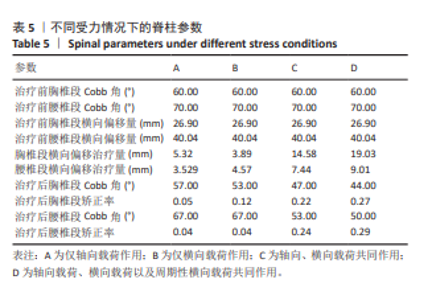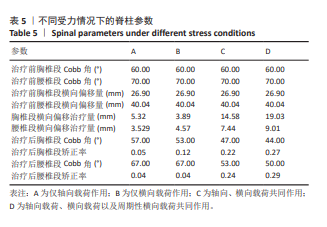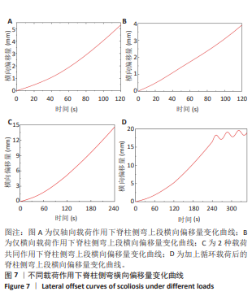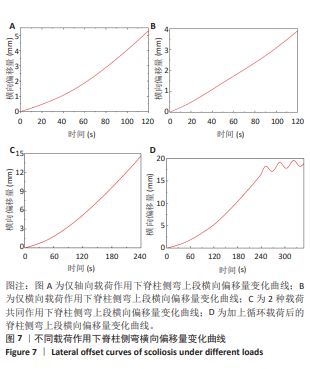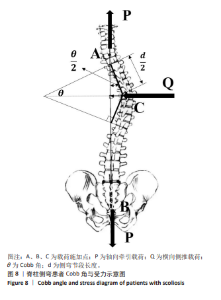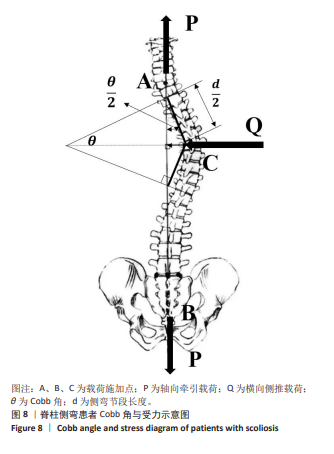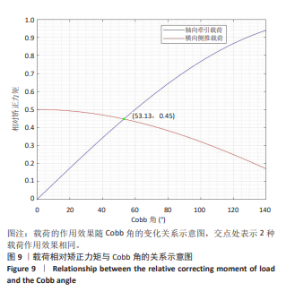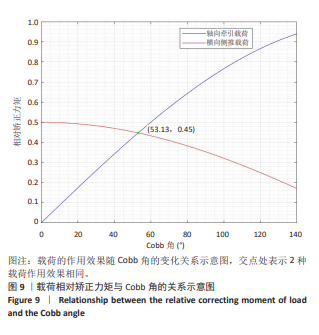Chinese Journal of Tissue Engineering Research ›› 2026, Vol. 30 ›› Issue (9): 2172-2181.doi: 10.12307/2026.116
Previous Articles Next Articles
Finite element simulation of scoliosis with muscle unit introduction: verification of correction effect under bidirectional load
Wu Hongxu1, Liu Xuanyu2, Wang Taoyu1, Wang Shiyao1, Cheng Jingyi3, Zhang Mingwen1, Zhang Yinxia1, Liu Zhihua1, Wang Xiaojie1
- 1School of Mechanical and Power Engineering, 3Business School, Zhengzhou University, Zhengzhou 450001, Henan Province, China; 2South Ural College, Zhengzhou University of Aeronautics, Zhengzhou 450046, Henan Province, China
-
Received:2025-03-05Accepted:2025-05-15Online:2026-03-28Published:2025-08-21 -
Contact:Liu Zhihua, MD, Associate professor, School of Mechanical and Power Engineering, Zhengzhou University, Zhengzhou 450001, Henan Province, China Wang Xiaojie, MS, Lecturer, School of Mechanical and Power Engineering, Zhengzhou University, Zhengzhou 450001, Henan Province, China -
About author:Wu Hongxu, School of Mechanical and Power Engineering, Zhengzhou University, Zhengzhou 450001, Henan Province, China -
Supported by:Henan Province Industry-University-Research Cooperation Project, No. 142107000011 (to LZH); Horizontal Project of Zhengzhou University, No. 20230643A (to LZH)
CLC Number:
Cite this article
Wu Hongxu, Liu Xuanyu, Wang Taoyu, Wang Shiyao, Cheng Jingyi, Zhang Mingwen, Zhang Yinxia, Liu Zhihua, Wang Xiaojie. Finite element simulation of scoliosis with muscle unit introduction: verification of correction effect under bidirectional load[J]. Chinese Journal of Tissue Engineering Research, 2026, 30(9): 2172-2181.
share this article
Add to citation manager EndNote|Reference Manager|ProCite|BibTeX|RefWorks
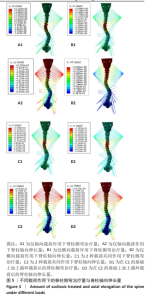
2.1 不同载荷作用下的脊柱侧弯治疗效果 为了更好地反映轴向牵引载荷与横向侧推载荷共同作用于治疗脊柱侧弯的效果,此文对二者单独作用于脊柱侧弯矫正同样进行了仿真求解,见图5及表5。 仅轴向载荷作用下脊柱侧弯处胸椎段的最大横向偏移治疗量为5.319 mm,相比治疗前改变了19.77%,腰椎段的最大治疗量为3.529 mm,相比治疗前改变了8.8%,Cobb角矫正率分别为5%和4%(图5A1,表5)。 仅横向载荷作用下脊柱侧弯处胸椎段的最大横向偏移治疗量为3.894 mm,相比治疗前改变了14.47%,腰椎段的最大偏移量为4.57 mm,相比治疗前改变了11.41%,Cobb角的矫正率分别为12%和4%(图5B1,表5)。 两种载荷共同作用于治疗脊柱侧弯时,可以看出,脊柱侧弯处胸椎段和腰椎段的横向偏移量分别改变了54.2%和18.57%,Cobb角的矫正率分别为22%和24%(图5C1,表5)。 在两种载荷共同作用的基础上,再加上周期性横向载荷进一步治疗脊柱侧弯,可以看出,加上循环载荷之后,脊柱侧弯胸椎段横向偏移治疗量相比之前增加了4.45 mm,脊柱侧弯腰椎椎段横向偏移治疗量相比之前增加了1.571 mm,Cobb角的矫正率分别为27%和29%,相比之前都增加了5%,治疗效果进一步提高(图5D1,表5)。 图5中D2显示,脊柱最大轴向总伸长量为17.01 mm,增加了3.037 5%,而文献资料中显示,脊柱从中立位完全屈曲可使脊柱长度增加35%[40],因此,该要素在脊柱侧弯矫正载荷作用下符合生理实际,同时也验证了仿真模型的有效性。"

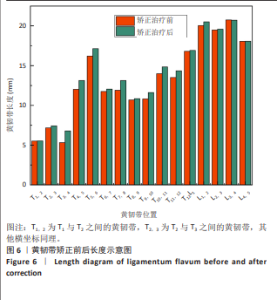
2.2 载荷作用下脊柱韧带及偏移量仿真结果 脊柱韧带在人体中扮演着重要的支撑和稳定作用,它连接着脊椎骨之间的关节,以及脊椎骨与骨盆之间的关节,在维持脊柱结构的稳定性和保持正常生理曲度方面发挥着重要作用[41-43]。韧带中含有大量的弹性纤维[44],而黄韧带中占比更高。因此以黄韧带为例,其连接相邻的上下位椎弓板,分节存在。此文测量仿真前后脊柱形变量最大处的黄韧带变形量,见图6。 从图6中可以计算出,黄韧带变形量最小处是L4,5,矫正前后分别为18.051 4,18.070 7 mm,变形率为0.11%,最大处是T3,4,矫正前后分别为 5.311 3,6.786 33 mm,变形率为27.7%。WHITE[45]的研究中表明,正常情况下,脊柱从中立位完全屈曲时,黄韧带被额外拉伸其长度的35%,而此次研究中黄韧带的伸长量远没有达到。并且根据ROLANDER[46]的测量,NACHEMSON等[44]对瞬时运动中心的位置进行了近似计算,并计算出伴随完全背腹屈曲的韧带延伸约为7.5 mm,此次研究最大处T3,4的黄韧带伸长量为1.473 33 mm,小于7.5 mm,符合NACHEMSON和WHITE的研究,因此,该要素在脊柱侧弯矫正载荷作用下符合生理实际,同时也验证了仿真模型的有效性。 图7为脊柱侧弯处胸椎段的横向偏移治疗量随着载荷而变化的曲线示意图,随着时间的增加,脊柱侧弯偏移量也在逐渐增加,由于Abaqus的特性,添加在骶骨上的载荷是呈线性逐渐增加的,但脊柱侧弯横向偏移治疗量并不是呈线性增长趋势,这是因为脊柱侧弯偏移量的变化使得患者的Cobb角减小,从而使得此侧弯处所受的力矩发生了改变。"
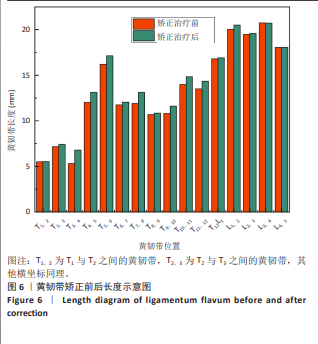

2.3 轴向牵引载荷与横向侧推载荷的作用效果研究 为了探究力矩对不同脊柱侧弯矫正载荷的矫正效果的影响,下面分析在2种载荷结合治疗时,什么力矩情况下轴向载荷的作用大于横向载荷,什么力矩情况下横向载荷的作用大于轴向载荷,这样便可以在对患者治疗时得到二者作用的先后顺序,或者同时施加时哪种载荷占主导作用,从而为患者提供定制化治疗方案,以提高治疗效果以及效率。脊柱侧弯患者Cobb角与受力示意图见图8。 图8中横向载荷施加于曲线顶点C处,轴向载荷分别施加于两侧的A、B两点。此时,两种载荷的相对矫正能力可以从顶点C处的弯矩大小中得出,由以下分析给出。 当脊柱受到轴向载荷时,脊柱侧弯曲线顶点C处的弯矩为: "

| [1] 王媛媛,王辉昊,丁立鹏,等.上海市中小学生脊柱侧弯现状及影响因素分析[J].颈腰痛杂志,2025,46(1):84-88. [2] WIJNGAARDE CA, BRINK RC, DE KORT FAS, et al. Natural course of scoliosis and lifetime risk of scoliosis surgery in spinal muscular atrophy. Neurology. 2019;93(2):e149-e158. [3] TUĞBA KÇ, DURMUŞ BB, ECE ZS, et al. Systematic review of clinical outcome parameters of conservative treatment of adolescent idiopathic scoliosis patients. J Clin Med. 2025;14(4):1063. [4] PETROSYAN E, FARES J, AHUJA CS, et al. Genetics and pathogenesis of scoliosis. NASSJ. 2024: 100556. [5] 张玉芳,郭海伟,吕蒙,等.脊柱侧弯矫正力计算分析[J].机械设计与制造,2025(7):30-34. [6] 陈静静,孙锡杰,李婉.长三角地区中学生脊柱弯曲现状及影响因素[J].中国学校卫生,2023,44(1):135-138. [7] 李梦,曲亚斌,孙艺,等.广东省中小学生脊柱侧凸流行特征及影响因素分析[J].中国学校卫生,2022,43(2):292-295. [8] NEGRINI S, AULISA AG, AULISA L, et al. 2011 SOSORT guidelines: orthopaedic and rehabilitation treatment of idiopathic scoliosis during growth. Scoliosis. 2012;7:1-35. [9] KIM H, CHANG BS, CHANG SY. Current issues in the treatment of adolescent idiopathic scoliosis: a comprehensive narrative review. Asian Spine J. 2024;18(5):731-742. [10] WILKE HJ, GROßKINSKY M, RUF M, et al. Range of international surgical strategies for adolescent idiopathic scoliosis: Evaluation of a multi‐center survey. J Spine. 2024;7(2):e1324. [11] KIRAM A, HU Z, MA H, et al. Development of ethnicity-adjusted global alignment and proportion score to predict the risk of mechanical complications following corrective surgery for adult spinal deformity. Spine J. 2024;24(5):877-888. [12] ANSARI K, SINGH M, MCDERMOTT JR, et al. Adolescent idiopathic scoliosis in adulthood. Efort Open Rev. 2024;9(7):676-84. [13] 李苗秀,朱博文,孔令军,等.青少年脊柱侧弯保守治疗临床评估工具研究进展[J].中国全科医学,2025,28(24):3079-3088. [14] ZUHAIMI UH, SIDEEK MA M, ISMAIL AFH. Effectiveness of Lyon Method In Treating Adolescent Idiopathic Scoliosis: A Scoping Review. Int J Health Sci. 2024. [15] BŁACHNIO K, KOPCIAŁ S, PIECUCH D, et al. Conservative treatment of adolescent idiopathic scoliosis (AIS): A narrative review of current evidence and implications for clinical practice. Qual Sport. 2024;22: 54352-54352. [16] ZHANG Q, BÍRÓ I. Biomechanical Analysis and Modeling of Different Traction Patterns in Adolescent Idiopathic Scoliosis. Anal Tech Szegedin. 2024;18(3):88-100. [17] 张浩阳,潘英森,叶鑫,等.牵引干预治疗青少年特发性脊柱侧弯的应用现状[J].中医儿科杂志,2024,20(4):92-95. [18] 王东旭,李峰平,孙冬,等.治疗青少年特发性脊柱侧弯的牵引方法:有限元研究[C]//中国体育科学学会.2024年国际竞技体育生物力学论坛暨第二十三届全国运动生物力学学术交流大会论文摘要集.宁波大学,体育学院,2024. [19] 夏纪元,杨云飞,黄立军,等.Halo-骨盆牵引治疗重度脊柱侧弯畸形的效果及其对肺功能的影响[J].武警医学,2024,35(3):230-234. [20] WU L, ZHENG A, GUAN T, et al. Biomechanical analysis of scoliosis correction under the influence of muscular and external forces. J Clin Neurosci. 2025;132:110991. [21] HE W, LI JL, WANG JY, et al. Optimization of traction parameters for lumbar scoliosis. BMC Musculoskelet Disord. 2024;25(1):472. [22] WANG J, LI Q, FENG F, et al. Measurement of Corrective Force Changes Under Scoliosis Brace in Different Spine Postures. BSN 2024. IEEE, 2024:1-4. [23] 黄凯, 柳超. 应用三维有限元方法评价寰椎横韧带对寰枢椎复合骨折稳定性的影响[J]. 中国临床研究,2024,37(5):729-734. [24] TONG H, HALILAJ E, ZHANG YJ. HybridOctree_Hex: Hybrid octree-based adaptive all-hexahedral mesh generation with Jacobian control. J Comput Sci. 2024;78:102278. [25] EL RM, ARNOUX PJ, WAGNAC E. Finite element investigation of the loading rate effect on the spinal load-sharing changes under impact conditions. J Biomech. 2009;42(9):1252-1262. [26] 李文成.脊柱矫正力的计算与分析[D].大连:大连交通大学,2018. [27] 汤清.颈椎牵引新设备的研究及全颈椎模型的建立与仿真[D].郑州:郑州大学,2018. [28] 何俊霖.基于3D打印智能脊柱矫形系统研究[D].杭州:杭州电子科技大学,2023. [29] TAKASHIMA ST, SINGH SP, HADERSPECK KA, et al. A model for semi-quantitative studies of muscle actions. J Biomech. 1979;12(12): 929-939. [30] WYNARSKY GT, SCHULTZ AB. Optimization of skeletal configuration: studies of scoliosis correction biomechanics. J Biomech. 1991;24(8): 721-732. [31] 黄莞沨,曲爱丽,李立,等.人体脊柱动力学数值仿真分析模型建立及验证[J].医用生物力学,2024,39(2):250-257. [32] 陈群响,倪斌,郭群峰,等.带肌肉组织全颈椎三维有限元模型的建立及分析[J].中国脊柱脊髓杂志,2019,29(4):348-355. [33] SCHMIDT H, SHIRAZI-ADL A, GALBUSERA F, et al. Response analysis of the lumbar spine during regular daily activities—a finite element analysis. J Biomech. 2010;43(10):1849-1856. [34] 刘治华,汤清,陶德岗,等.全颈椎三维有限元模型的建立及旋转牵引疗法研究[J].生物医学工程研究,2018,37(3):362-366+376. [35] HAMZAOGLU A, OZTURK C, AYDOGAN M, et al. Posterior Only Pedicle Screw Instrumentation With Intraoperative Halo-Femoral Traction in the Surgical Treatment of Severe Scoliosis (>100°). Spine (Phila Pa 1976). 2008;33(9):979-983. [36] WATANABE K, LENKE LG, BRIDWELL KH, et al. Efficacy of perioperative halo-gravity traction for treatment of severe scoliosis (≥100°). J Orthop Sci. 2010;15:720-730. [37] D’ASTOUS JL, SANDERS JO. Casting and Traction Treatment Methods for Scoliosis. Orthop Clin North Am. 2007;38(4):477-484, v. [38] 雷蕾,李文成,翟贇.Lenke1A/B型脊柱侧弯矫形生物力学计算分析[J].医用生物力学,2018,33(4):306-311. [39] 王莉,王纯,夏楠,等.脊柱侧凸康复机器人的研制及对冠状面畸形的即刻矫正效果初探[J].中华物理医学与康复杂志,2021,43(10): 899-903. [40] PANJABI MM, WHITE AA. Basic biomechanics of the spine. Neurosurgery. 1980;7(1):76-93. [41] EDWARDS CR, LIOU CJ, AHMED S, et al. A Case-Based Review of Spine Ligamentous Anatomy and Pathology. Contemp Diagn Radiol. 2024;47(17):1-8. [42] MANDEGARAN R, QUINN-LAURIN V. Spine anatomy. In: Clinical Atlas of Bone SPECT/CT. Springer Int Publ, 2024: 1199-1202. [43] 吴爱悯,郭振宇,王向阳.脊柱生物力学2023年度研究进展[J].医用生物力学,2024,39(2):187-196. [44] NACHEMSON AL, EVANS JH. Some mechanical properties of the third human lumbar interlaminar ligament (ligamentum flavum). J Biomech. 1968;1(3): 211-220. [45] WHITE A. Clinical biomechanics of the spine. Clin Biomech Spine. 1990. [46] ROLANDER SD. Motion of the lumbar spine with special reference to the stabilizing effect of posterior fusion: an experimental study on autopsy specimens. Acta Orthop Scand. 1966;37(sup90): 1-144. [47] WANG X, LI H, ZHU Q, et al. Effectiveness and safety of robot-assisted versus fluoroscopy-assisted pedicle screw implantation in scoliosis surgery: a systematic review and meta-analysis. Neurosurg Rev. 2024; 47(1): 108. [48] ELMESHNEB MA, HASSANIN MA, ELNADY B, et al. Surgical complications in neuromuscular scoliosis surgery: Systematic review and meta-analysis of the last ten years. Eur Spine J. 2024;33(7): 2666-2676. [49] ELREFAEY A. Iatrogenic descending thoracic aorta perforation by pedicle screws as a delayed complication of scoliosis correction surgery. The anesthetic management and TEE role. Saudi J Anaesth. 2025; 19(1):118-121. [50] FENG R, TAO H, YE C, et al. A quantitative biomechanical study for precise orthopedic intervention in idiopathic scoliosis. RCAR 2022, Guiyang, China, 2022:664-669. [51] CHEN ZQ, WANG CF, BAI YS, et al. Using Precisely Controlled Bidirectional Orthopedic Forces to Assess Flexibility in Adolescent Idiopathic Scoliosis. Spine (Phila Pa 1976). 2011; 36(20):1679-1684. |
| [1] | Zhou Daobin, Wang Kehao, Xie Yang, Ning Rende. Biomechanical characteristics of volar locking plate only versus combined dorsal mini-plate fixation of distal radius fractures with dorsal ulnar fragment [J]. Chinese Journal of Tissue Engineering Research, 2026, 30(9): 2255-2261. |
| [2] | Zeng Xuan, Weng Rui, Ye Shicheng, Tang Jiadong, Mo Ling, Li Wenchao. Two lumbar rotary manipulation techniques in treating lumbar disc herniation: a finite element analysis of biomechanical differences [J]. Chinese Journal of Tissue Engineering Research, 2026, 30(9): 2153-2161. |
| [3] | Liu Jiafu, Ren Ruxia, Liao Zhouwei, Zhou Xiali, Wu Yihong, Zhang Shaoqun. Three-dimensional finite element analysis of cervical spine biomechanical characteristics in a rat model of cervical vertigo [J]. Chinese Journal of Tissue Engineering Research, 2026, 30(9): 2182-2190. |
| [4] | Zheng Wangyang, Fei Ji, Yang Di, Zhao Lang, Wang Lingli, Liu Peng, Li Haiyang. Finite element analysis of the force changes of the supraspinatus tendon and glenohumeral joint during the abduction and flexion of the humerus [J]. Chinese Journal of Tissue Engineering Research, 2026, 30(9): 2199-2207. |
| [5] | Cai Qirui, Dai Xiaowei, Zheng Xiaobin, Jian Sili, Lu Shaoping, Liu Texi, Liu Guoke, Lin Yuanfang. Mechanical effects of Long’s traction orthopedic method on cervical functional units: quantitative analysis of biomechanical model of head and neck [J]. Chinese Journal of Tissue Engineering Research, 2026, 30(9): 2208-2216. |
| [6] | Rao Jingcheng, Li Yuwan, Zheng Hongbing, Xu Zhi, Zhu Aixiang, Shi Ce, Wang Bing, Yang Chun, Kong Xiangru, Zhu Dawei. Biomechanical differences between the new proximal femoral stable intramedullary nail and traditional intramedullary nail#br# [J]. Chinese Journal of Tissue Engineering Research, 2026, 30(9): 2217-2225. |
| [7] | Chen Long, Wang Xiaozhen, Xi Jintao, Lu Qilin. Biomechanical performance of short-segment screw fixation combined with expandable polyetheretherketone vertebral body replacement in osteoporotic vertebrae [J]. Chinese Journal of Tissue Engineering Research, 2026, 30(9): 2226-2235. |
| [8] | Yan Xiangning, Chen Lei, Chen Yonghuan, Wang Chao, Li Xiaosheng. Influence of different depths and loads on knee joint mechanics and peripheral muscle force characteristics during squatting [J]. Chinese Journal of Tissue Engineering Research, 2026, 30(9): 2236-2247. |
| [9] | Zhang Nan, Meng Qinghua, Bao Chunyu. Characteristics and clinical application of ankle joint finite element models [J]. Chinese Journal of Tissue Engineering Research, 2026, 30(9): 2343-2349. |
| [10] | Liu Jinlong, Abuduwupuer·Haibier, Bai Zhen, Su Danyang, Miao Xin, Li Fei, Yang Xiaopeng. Efficacy of different nonsurgical treatments for adolescent idiopathic scoliosis: a systematic review and network meta-analysis [J]. Chinese Journal of Tissue Engineering Research, 2026, 30(9): 2370-2379. |
| [11] | Zhang Xianxu, Ma Zhong, Liu Xin, Huang Lei, Shen Wenxiang, Luo Zhiqiang . Lumbar fusion combined with unilateral fixation for lumbar degenerative diseases: biomechanics, technical evolution, and clinical applications [J]. Chinese Journal of Tissue Engineering Research, 2026, 30(9): 2334-2342. |
| [12] | Zhong Caihong, Xiao Xiaoge, Li Ming, Lin Jianhong, Hong Jing. Biomechanical mechanism of sports-related patellar tendinitis [J]. Chinese Journal of Tissue Engineering Research, 2026, 30(6): 1417-1423. |
| [13] | Shang Depeng, Wei Haiyu, Yang Fan. Finite element analysis for three different types of internal screw fixation in treatment of severe lumbar 1 vertebral body fractures [J]. Chinese Journal of Tissue Engineering Research, 2026, 30(3): 537-545. |
| [14] | Guan Yujie, Zhao Bin. Application and prospect of artificial intelligence in screening and diagnosis of scoliosis [J]. Chinese Journal of Tissue Engineering Research, 2026, 30(3): 721-730. |
| [15] | Yu Xinlin, Chen Huiyu, Wang Yingying, Guo Weizhong, Feng Bin Lin Chengshou, Lin Wang. Finite element analysis of internal fixation with new retrograde intramedullary nail on lateral femur condyle for distal type A2 femur fractures [J]. Chinese Journal of Tissue Engineering Research, 2026, 30(3): 546-552. |
| Viewed | ||||||
|
Full text |
|
|||||
|
Abstract |
|
|||||
